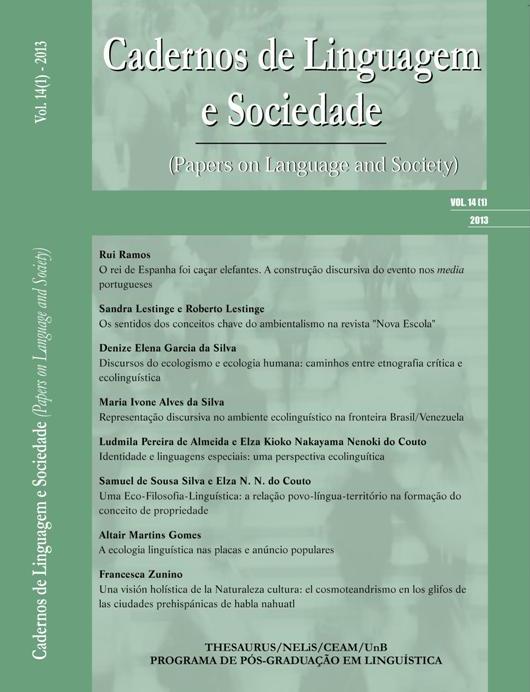ANÁLISE ETNOSSEMÂNTICA DE NOMES COMUNS DE ABELHAS E VESPAS (INSECTA, HYMENOPTERA) NA TERRA INDÍGENA PANKARARÉ, BAHIA, BRASIL
DOI:
https://doi.org/10.26512/les.v14i1.22248Keywords:
Ethnoentomology. Ethnotaxonomy. Traditional knowledge. Semantics.Abstract
This paper focuses on the ethnotaxonomy and significance of bees and wasps to the Pankararé Indians living in a semi-arid zone of the Northeast of the Bahia State, Brazil. The data were obtained by means of open-ended interviews performed with 14 individuals (nine men and five women) from Brejo do Burgo village. A total of 23 ethnospecies were recorded within the ethnocategory “abeia”, the label used for both Apidae and Vespidae. These “abeias” are classified in two groups as “fierce bees” and “mild bees”, and in three intermediate taxa depending upon whether or not they sting and, if so, if they can sting repeatedly. These insects play significant roles in the social, economical, and cultural life of this group.
Downloads
References
ATRAN, S. Folk biology and the anthropology of science: cognitive universals and cultural particulars. Behavioral and Brain Sciences, 21(4): 547-569, 1998.
ATRAN, S. Cognitive foundations of natural history. Londres: Cambridge University Press, 1990.
BANDEIRA, F. P. S. F. Etnobiologia Pankararé. Monografia. Salvador: Universidade Federal da Bahia, 1993.
BERLIN, B. Ethnobiological classification: principles of categorization of plants and animals in traditional societies. New Jersey: Princeton University Press, 1992.
BRASIL, Ministério das Minas e Energia. Projeto “RADAMBRASIL”. Aracaju/Recife: geologia, geomorfologia, pedologia, vegetação e uso potencial da terra, Brasília: Ministério das Minas e Energia, 1983.
BROWN, C. H. Folk zoological life-forms: their universality and growth. American Anthropologist, 81(4): 791-812, 1979.
BROWN, C. H. Language and living things: uniformities in folk classification and naming. New Brunswick: Rutgers University Press, 1984.
BROWN, C. H. Mode of subsistence and folk biological taxonomy. Current Anthropology, 26: 43-64, 1985.
BUZZI, Z. J. Coletânea de nomes populares de insetos do Brasil. Curitiba: Universidade Federal do Paraná, 1994.
Centro de Estatística e Informações. nformações básicas dos municípios baianos. Região Nordeste. Salvador: Governo do Estado da Bahia, 1994.
COUTO, H. H. Ecolingüística: estudo das relações entre língua e meio ambiente. Brasília: Thesaurus, 2007.
Ellen, R. F. The cultural relations of classification: an analysis of Nuaulu animal categories from central Seram. Cambridge: Cambridge University Press, 1993.
HAYS, T. E. Ndumba folk biology and general principles of ethnobotanical classifications and nomenclature. American Anthropologist, 85: 592-611, 1983.
HUNN, E. The utilitarian factor in folk biological classification. American Anthropologist, 84: 830-847, 1982.
HUNN, E. Tzeltal folk zoology: the classification of discontinuities in nature. Berkeley: University of California, 1997.
LENKO, K.; PAPAVERO, N. Insetos no folclore. São Paulo: Cons. Est. Art. Cienc. Hum, 1979.
MACHADO, I. C. S. Biologia floral de espécies de caatinga no município de Alagoinha (PE). Tese de Doutorado, USP, 1990.
MAFFI, L. Language and the environment. In: POSEY, D. A. (org.). Cultural and spiritual values of biodiversity, p. 22-29. Londres: ITP, 1999.
MAIA, S. M. Os Pankararé do Brejo do Burgo: campesinato e etnicidade. Monografia. Salvados: Universidade Federal da Bahia, 1992.
NOLAN, J. M.; ROBBINS, M. C. E. Emotional meaning and the cognitive organization of ethnozoological domains. Journal of Linguistic Anthropology, 11(2): 240-249, 2001.
NOLAN, J. M.; JONES, K. E.; MCDOUGAL, K. W.; MCFARLIN, M. J.; WARD, M. K. The lovable, the loathsome, and the liminal: emotionality in ethnozoological cognition. Journal of Ethnobiology, 26(1): 126-138, 2006.
PINTO, E. As máscaras-de-dansa dos Pancararu de Tacaratu (remanescentes indígenas dos sertões de Pernambuco). Nordeste Indígena, sér. Etnohistória, 2: 5-15, 1991.
POSEY, D. A. Topics and issues in ethnoentomology with some suggestions for the development of hypothesis-generation and testing in ethnobiology. Journal of Ethnobiology, 6(1): 99-120, 1986.
REVEL, N. Fleurs de paroles: histoire naturelle Palawan I: lens dons de Nägsalad. Paris: Editions Peeters, 1994.
ROUBIK, D. W. Ecology and natural history of tropical bees. Cambridge: Cambridge University Press, 1989.
SANTOS-FITA, D.; Costa Neto, E. M. Sistemas de clasificación etnozoológicos. In: COSTA NETO, E. M.; SANTOS-FITA, D.; VARGASCLAVIJO, M. (orgs.). Manual de Etnozoología: una guía teórico-práctica para investigar la interconexión del ser humano con los animales, p. 67-94. Valencia: Tundra Ediciones, 2009.
STURTEVANT, W. C. Studies in ethnoscience. American Anthropologist, 66(30): 99-131, 1964.
VIERTLER, R. Métodos antropológicos como ferramenta para estudos em etnobiologia e etnoecologia. In: AMOROZO, M. C. M.; MING, L. C.; SILVA, S. M. P. (org.). Métodos de coleta e análise de dados em etnobiologia,
etnoecologia e disciplinas correlatas, , pp. 11-29. Rio Claro: UNESP/CNPq, 2002.



